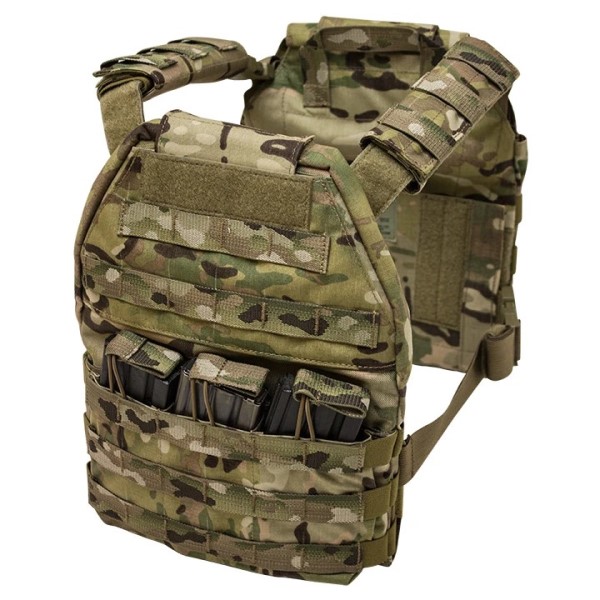Some plate carriers are a barebones vessel meant to simply hold the plates in the right spot over your chest and back. Other carriers become the foundation for equipment you want to carry on your body in a combat situation, such as extra magazines, a radio, an individual first aid kit or tourniquet, hydration, and even specialized backpacks.
Keep in mind the scenario / context of when you might be wearing body armor (which is heavy and restricts movement). If you’re on a long range rural scout, for example, you’ll probably optimize for lower weight and won’t wear your armor at all, instead using something like a chest rig, belt, and/or backpack. But if you’re defending your home as your city collapses around you, you’d rather carry more weight and wear the armor since the chances of close combat are higher.
The most important bits:
- There are a lot of excellent options around $150, but top-of-the-line medium and minimal carriers will cost around $300.
- Don’t buy cheap. Since armor is heavy, sometimes abrasive (eg. the spall coating on steel armor), and will likely be jostled around as you move in an emergency, cheap materials and stitching are known to fall apart in the field. Many of the cheaps carriers are meant for airsoft, weighted exercising (eg. Crossfit), and LARPing mall ninjas — not real combat.
- If you’re on a budget and don’t have either the carrier or the plates yet, you may as well buy the carrier first since you can still use it as a gear platform without armor, but you can’t run the armor without the carrier. Just know what size and shape plates you’ll want before buying the carrier.
- It’s okay to buy used, but check the fabric and seams for damage before buying.
- Plate carrier sizes are usually labeled by the size of the plate they hold, not your general body / clothing size. But those labels can get confused from one website to another, so pay extra attention to sizing when trying to match your plates and carrier.
- Carriers are meant for an even number of plates — most people carry 2 or 4. You wouldn’t just run a carrier with a plate on the front of your chest but not the back, for example, because then the whole platform would be lopsided.
- Most people use two plates, front and back. Carriers can hold smaller side plates under your armpit, but in practice, you wouldn’t use the side plates outside of the most dangerous scenarios.
- “Emergency doffing” is an important feature that means you (or a buddy) can very quickly remove the whole carrier from your body; often just a single pull of a cord. That’s important when you’re injured or stuck.
- Neutral colors are usually better than camo for most people, since you’re more likely to wear the carrier in an urban or suburban setting compared to nature. Tactical plate carriers are still uncommon enough that they will stick out in something like civil unrest, and camo just makes that worse.
- Women have a tough time with this market, but we highlight some options below. Manufacturers don’t think about women as much since their customers are usually front-line soldiers and law enforcement. Plus there’s the simple physics of trying to hold a heavy, flat, and rigid plate tightly over breasts.
- Hard armor is already pretty heavy, so don’t make it worse with a carrier that’s bigger than it needs to be. Go as minimalist as you can while keeping your attached gear in mind (eg. magazines).
What kind of criteria you should look for and other basics are below the fold.
After 30 hours of research (on top of our years of personal experiences), including reviewing over 80 products and interviews with law enforcement and military personnel, these are our top choices in different categories to help shortcut your shopping.
Medium Plate Carriers — heaviest of the options we consider, but with the most flexibility as a platform for other gear, MOLLE attachments, etc:
- 5.11 TacTec $210
- Crye JPC 2.0 $240
- Agilite K19 Plate Carrier $270
- Grey Ghost SMC Plate Carrier $320
- First Spear Strandhogg $530
Minimalist Plate Carriers — lighter, but can still function as a gear platform:
- 5.11 Prime Plate Carrier $100
- Crye AirLite SPC $170
- Ferro Concepts DCPD V5 Base $265
- DFNDR QRC Plate Carrier $330
- First Spear AAC $540
Slick Plate Carriers — best for blending in, lightweight, but won’t carry a lot of gear:
- First Spear Slick $120
- Shellback Tactical Stealth Low Vis $150
- Ferro Concepts Slickster $160
- LBT Slick Plate Carrier $270
- First Spear Decepter $265
Female Plate Carriers:
- Shellback Banshee Rifle Plate Carrier $230 (Will work with the RMA female-cut plate)
- Tyr Tactical PICO – MV Assaulters Plate Carrier – Female $1,295 (includes plates)
- Tyr Tactical EPIC Enhanced PICO Integrated Carrier – Female $1,500 (includes plates)
Be prepared. Don’t be a victim.
Want more great content and giveaways? Sign up for The Prepared’s free newsletter and get the best prepping content straight to your inbox. 1-2 emails a month, 0% spam.
Types of plate carriers
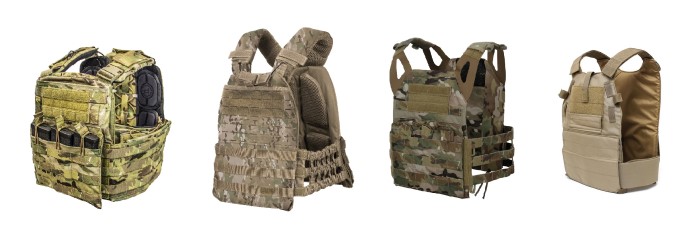
There are a staggering amount of plate carriers on the market, but they all fall within four categories:
- Heavy armor systems are ruggedly constructed and well padded to accommodate heavy loads of 35 pounds or more. These systems are overkill for civilians, so we ignore them.
- Medium plate carriers are the sweet spot for most people who still want to carry more gear than just the plates themselves. Can comfortably carry 20-30 pounds.
- Minimalist plate carriers have less padding and attachment points. Good for 15-25 pounds.
- Slick carriers are the barebones basics, designed to blend in or be worn underneath clothing. Slick carriers may not have the emergency doffing (removal) options that Medium and Minimalist carriers have, but can be easy to get in and out of.
Sizes, shapes, and fit
The size of the plate carrier is labeled based on the size of the plates it holds, not your clothing size. The rest of the rig is usually considered one-size-fits-all because there’s a lot of room for adjustment in the shoulder straps and cumberbund.
More: See the best body armor review for tips on sizing.
When shopping for carriers, pay extra attention to the specs and don’t be afraid to ask for more info about sizing. Part of the difficulty as a civilian buyer is the different standards of sizing and labels, which can make it hard to match a size from one brand with the size from another.
For example: The military’s SAPI standard says a Medium plate is 9.5 x 12.5 inches. But some civilian and law enforcement ‘standards’ use 10 x 12 inches. If you buy a Medium SAPI plate and a carrier labeled as Medium from some other non-SAPI standard, that extra half inch of width might make it hard to wiggle the plate inside its pouch.
Tip: Even if you’re buying the carrier before the plates, you’ll first want to know what size plates you’ll end up with.
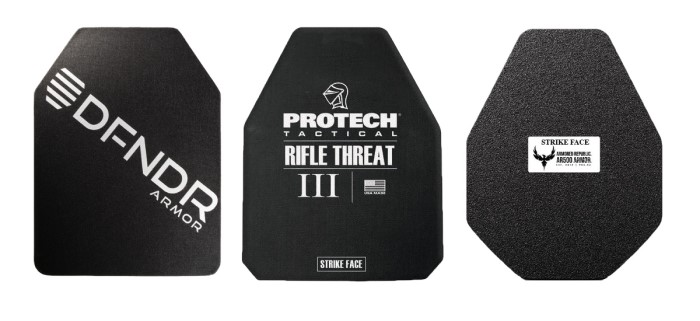
Plates come in different shapes. While some carriers will be ‘smaller’ to be a tailor-fit for the more angular cuts (eg. swimmers), we recommend sticking with a standard SAPI / square cut carrier.
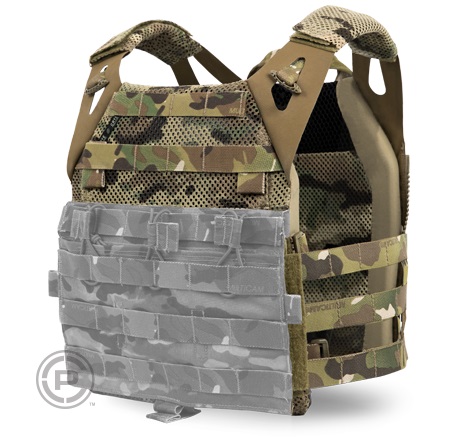
You can always put a more angular cut inside the ‘square’ pouch with some extra room around the edges. But you can’t do the opposite. Don’t worry about the small extra space around the corners of the plate — it doesn’t bother most people, or you can stick some cotton/whatever in to fill the gaps.
Women’s plate carriers
The industry is trying to catch up as more women enter combat and law enforcement roles. For example, RMA Armament will start offering female plates in 2021.
It’s not so simple though, since there’s only so much you can do to make a hard plate comfortable when pressed against breasts for hours.
We’ve heard a general rule of thumb: If you’re usually comfortable going without a bra, you can probably make do with a ‘male’ / standard plate carrier. It won’t be great. But it’ll make do, especially for the small amount of times you’d ever wear it.
Some women find that the angular cuts (eg. swimmers) are more comfortable because of that little bit of extra room on the edges where your shoulder will move around. So if you’re very concerned about comfort, try those cuts with a female-specific carrier.
When trying things on, it’s okay if the plate pushes your breasts out to the side as long as it’s not causing you pain/harm or restricting basic arm movement. The point isn’t to protect your breasts — it’s to protect the vital organs underneath.
Emergency doffing and grab handles
These two features are particularly helpful for civilians, partly because you won’t have the training and muscle memory that professionals do. That means you’re more likely to get shot and more likely to fumble around with gear compared to a pro.
Note: Slick plate carriers often skip these features, which is okay in those cases since those carriers are optimizing purely for concealment.
Imagine you’re caught in a riot while wearing your armor. You get shot in an area just outside of the plate, causing a wound. That’s not the time you or someone helping you should be fumbling with undoing the cummerbund and removing the whole rig up and over your head (where a helmet, respirator, eye and ear protection, or other gear might make it even harder).
Emergency doffing doesn’t always work the same way from one model to another. But the spirit is always the same: You can make one simple and fast motion that breaks apart the rig so you can quickly get out. It’s the armor equivalent of a parachute ripcord.
That’s handy for injuries, if you suddenly find yourself in water and need to ditch weight, if your rig gets snagged on something, etc.
A less-interesting but still worthwhile feature is a grab handle on the upper back of the carrier. These are useful if you’re injured and someone needs to quickly drag you behind cover. Some carriers, like the Ferro Concepts Slickster, have an optional drag handle you can install.
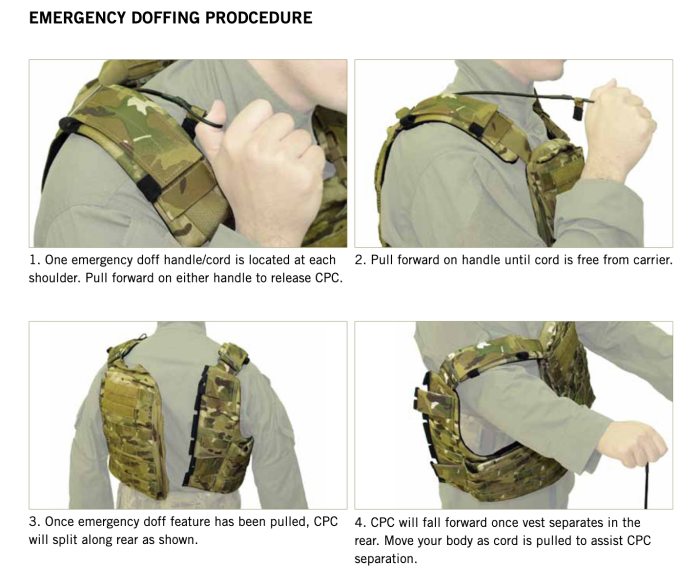
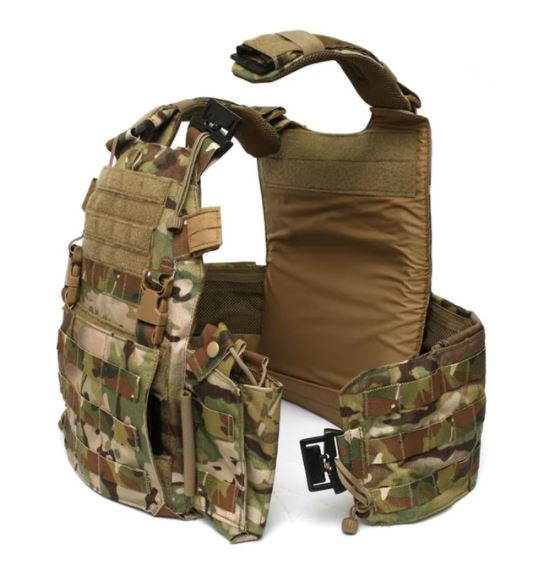
Customizing your rig
Adding accessories happens either through open standard interfaces, such as MOLLE/PALS webbing and G-hooks, or proprietary add-ons made by the same company.
The most common attachments are magazine holders, since that position over your tummy is one of the best places to rapidly grab new magazines if you find yourself in a firefight. Some models already have magazine holders built into that area of the carrier, kind of like an integrated kangaroo pouch.
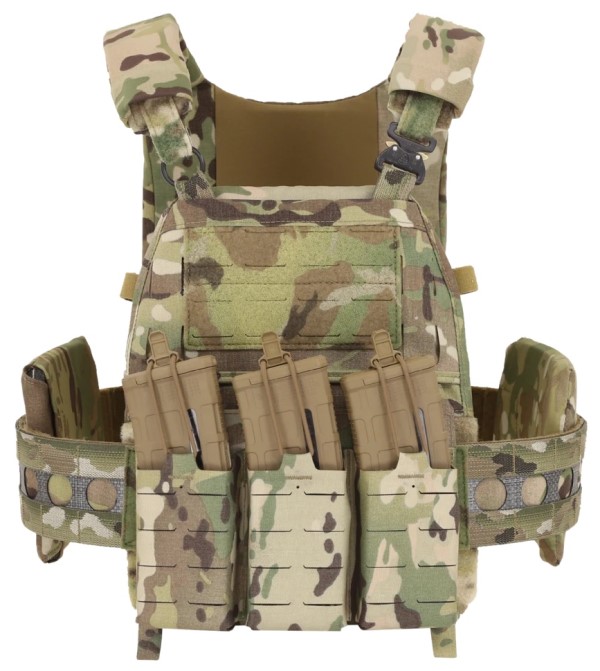
Other common attachments on the front are radio pouches, tourniquet holders, pistol or knife holsters, and general “‘admin” zip pouches.
Instead of piecing together separate pouches, some people like to have whole-package kits that are easy to swap on/off the carrier depending on what you expect to face that day. These “placards” make it easy to swap from a single velcro panel of three magazine holders to a different panel with more general storage pouches, for example.
You slip the carrier over your head, then attach the front and back panels together around the upper waist. That front-to-back connection is either a simple strap (shown above) or more robust cumberbund (below). The cumberbund acts as more space for mounting gear, including the smaller side armor plates that go under your arms
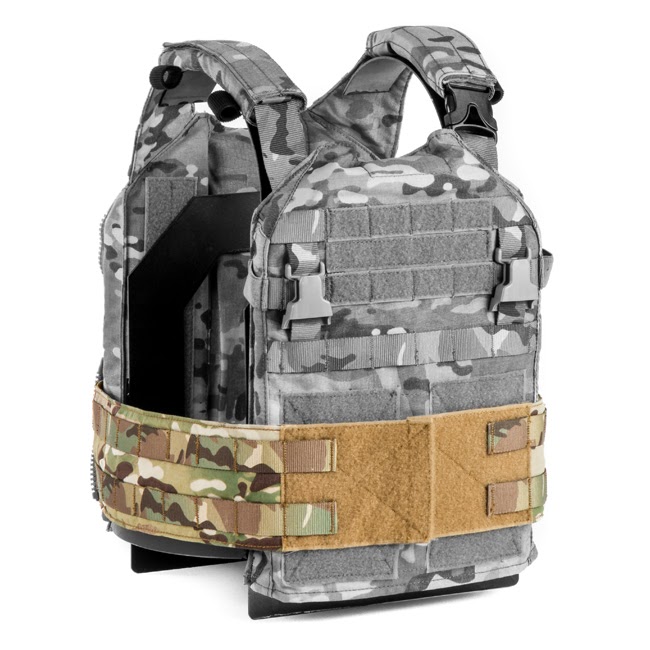
A few vendors offer cummerbunds as an aftermarket option. Some even feature built-in soft armor, like the FirstSpear Overlap Cummerbund.
The back side of some high-end carriers, like the Crye JPC 2.0, have attachment points / zippers to mount various backpack and loadout accessories on the read panel.
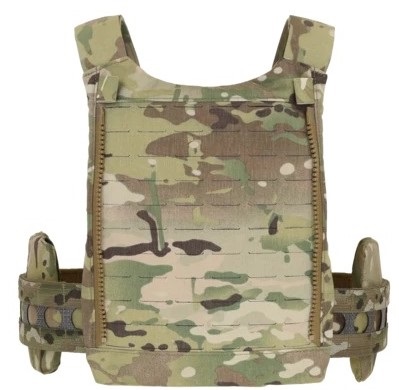
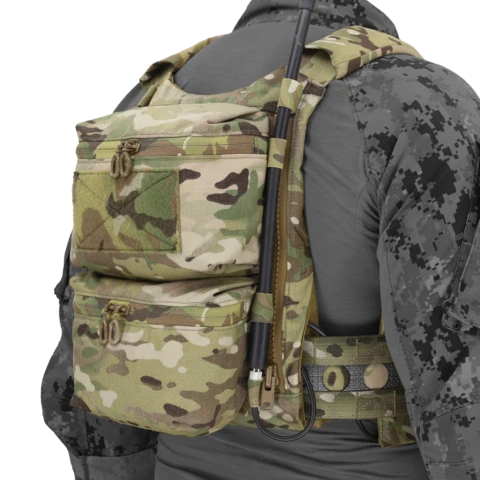
High-end plate carriers also feature zippers on the back of the carrier for accessories like small integrated backpacks and water storage pouches. You may never need these, but they are good to have. Usually, you’re better off wearing a backpack separate from the plate carrier so you can access the equipment inside without taking off the carrier or asking a buddy for help. However, be aware that the plate carrier and backpack may not play nicely together—that was a big drawback of the Marine Corps’s ILBE system.
Regarding backpacks, you also want to consider the plate carrier’s shoulder strap thickness. Some carriers, like the awesome 5.11 TacTec have thick straps suitable for days of wear. Others, like the Crye JPC 2.0, have thinner straps that may better accommodate backpack straps. For most preppers, thinner straps will probably work better. If you plan on putting a lot of weight on your carrier and not on your hips or backpack, look for thicker shoulder straps.

